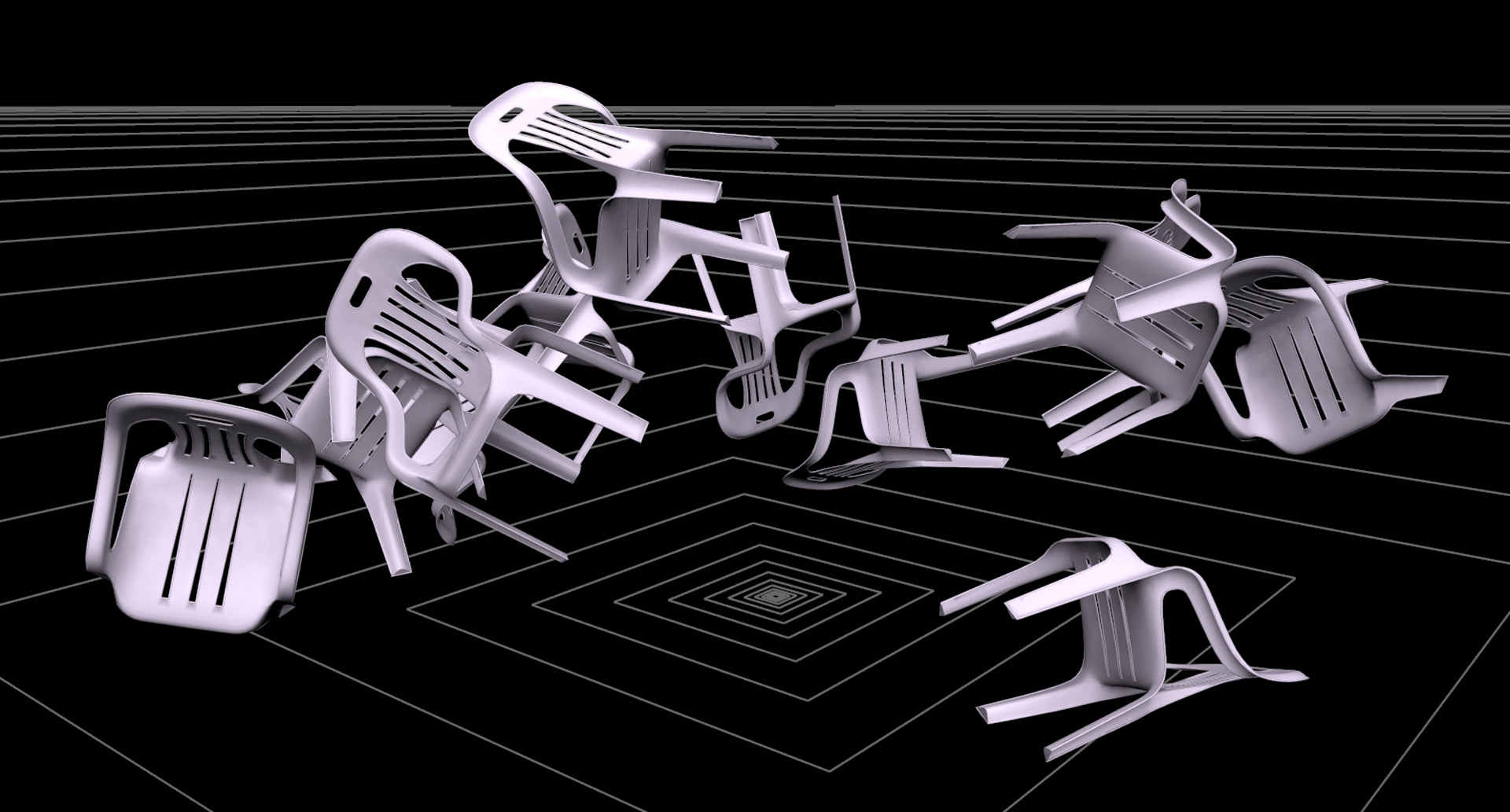“BD-tree: output-sensitive collision detection for reduced deformable models” by James and Pai
Conference:
Type(s):
Title:
- BD-tree: output-sensitive collision detection for reduced deformable models
Presenter(s)/Author(s):
Abstract:
We introduce the Bounded Deformation Tree, or BD-Tree, which can perform collision detection with reduced deformable models at costs comparable to collision detection with rigid objects. Reduced deformable models represent complex deformations as linear superpositions of arbitrary displacement fields, and are used in a variety of applications of interactive computer graphics. The BD-Tree is a bounding sphere hierarchy for output-sensitive collision detection with such models. Its bounding spheres can be updated after deformation in any order, and at a cost independent of the geometric complexity of the model; in fact the cost can be as low as one multiplication and addition per tested sphere, and at most linear in the number of reduced deformation coordinates. We show that the BD-Tree is also extremely simple to implement, and performs well in practice for a variety of real-time and complex off-line deformable simulation examples.
References:
1. ALEXA, M., AND MÜLLER, W. 2000. Representing Animations by Principal Components. Computer Graphics Forum 19, 3 (Aug.), 411–418.Google ScholarCross Ref
2. BRADSHAW, G., AND O’SULLIVAN, C. 2004. Adaptive Medial-Axis Approximation for Sphere-Tree Construction. ACM Transactions on Graphics 23, 1, 1–26. Google ScholarDigital Library
3. BRIDSON, R., FEDKIW, R. P., AND ANDERSON, J. 2002. Robust Treatment of Collisions, Contact, and Friction for Cloth Animation. ACM Transactions on Graphics 21, 3 (July), 594–603. Google ScholarDigital Library
4. BROWN, J., SORKIN, S., BRUYNS, C., LATOMBE, J., MONTGOMERY, K., AND STEPHANIDES, M. 2001. Real-Time Simulation of Deformable Objects: Tools and Application. In Proceedings of Computer Animation 2001.Google ScholarCross Ref
5. DEBUNNE, G., DESBRUN, M., CANI, M.-P., AND BARR, A. H. 2001. Dynamic Real-Time Deformations Using Space & Time Adaptive Sampling. In Proc. of ACM SIGGRAPH 2001, 31–36. Google ScholarDigital Library
6. DINGLIANA, J., AND O’SULLIVAN, C. 2000. Graceful Degradation of Collision Handling in Physically Based Animation. Computer Graphics Forum 19, 3 (Aug.), 239–248.Google ScholarCross Ref
7. FALOUTSOS, P., VANDE PANNE, M., AND TERZOPOULOS, D. 1997. Dynamic Free-Form Deformations for Animation Synthesis. IEEE Trans. on Vis. and Comp. Graph. 3, 3, 201–214. Google ScholarDigital Library
8. GANOVELLI, F., DINGLIANA, J., AND O’SULLIVAN, C. 2000. BucketTree: Improving collision detection between deformable objects. In Spring Conference in Computer Graphics (SCCG2000), 156–163.Google Scholar
9. GOTTSCHALK, S., LIN, M. C., AND MANOCHA, D. 1996. OBB-Tree: A Hierarchical Structure for Rapid Interference Detection. In Proceedings of ACM SIGGRAPH 96, 171–180. Google ScholarDigital Library
10. GUIBAS, L., NGUYEN, A., RUSSEL, D., AND ZHANG, L. 2002. Collision Detection for Deforming Necklaces. In Proceedings of the Eighteenth Annual Symposium on Computational Geometry, ACM Press, 33–42. Google ScholarDigital Library
11. HUBBARD, P. M. 1995. Collision Detection for Interactive Graphics Applications. IEEE Transactions on Visualization and Computer Graphics 1, 3, 218–230. Google ScholarDigital Library
12. JAMES, D. L., AND PAI, D. K. 1999. ARTDEFO: Accurate Real Time Deformable Objects. In Proceedings of ACM SIGGRAPH 99, Computer Graphics Proceedings, 65–72. Google ScholarDigital Library
13. JAMES, D. L., AND PAI, D. K. 2002. DyRT: Dynamic Response Textures for Real Time Deformation Simulation With Graphics Hardware. ACM Transactions on Graphics 21, 3, 582–585. Google ScholarDigital Library
14. JIMENEZ, P., THOMAS, F., AND TORRAS, C. 2001. 3D Collision Detection: A Survey. Computers and Graphics 25, 2 (Apr.), 269–285.Google ScholarCross Ref
15. LARSSON, T., AND AKENINE-MÖLLER, T. 2001. Collision Detection for Continuously Deforming Bodies. In Eurographics 2001, A. Chalmers and T.-M. Rhyne, Eds., Eurographics, 325–333.Google Scholar
16. LARSSON, T., AND AKENINE-MÖLLER, T. 2003. Efficient collision detection for models deformed by morphing. The Visual Computer 19, 2, 164–174.Google ScholarCross Ref
17. LEWIS, J. P., CORDNER, M., AND FONG, N. 2000. Pose Space Deformations: A Unified Approach to Shape Interpolation and Skeleton-Driven Deformation. In Proceedings of ACM SIGGRAPH 2000, 165–172. Google ScholarDigital Library
18. LIN, M. C., AND GOTTSCHALK, S. 1998. Collision detection between geometric models: A survey. In Proc. of IMA Conference on Mathematics of Surfaces, 37–56.Google Scholar
19. MANOCHA, D., LIN, M. C., DOGGETT, M., GREENE, N., HOFF, K., KILGARD, M., AND KRISHNAN, S. 2002. Interactive Geometric Computations Using Graphics Hardware. In SIGGRAPH 2002 Course Notes, ACM SIGGRAPH.Google Scholar
20. QUINLAN, S. 1994. Efficient Distance Computation between Non-Convex Objects. In IEEE Intern. Conf. on Robotics and Automation, IEEE, 3324–3329.Google ScholarCross Ref
21. VAN DEN BERGEN, G. 1997. Efficient Collision Detection of Complex Deformable Models using AABB Trees. Journal of Graphics Tools 2, 4, 1–14. Google ScholarDigital Library
22. WARREN, J., AND WEIMER, H. 2001. Subdivision Methods for Geometric Design: A Constructive Approach, first ed. Morgan Kaufmann Publishers, October. Google ScholarDigital Library
23. WELZL, E. 1991. Smallest enclosing disks (balls and ellipsoids). In New Results and New Trends in Comp. Sci., H. Maurer, Ed., vol. 555 of Lecture Notes Comp. Sci. Springer-Verlag, 359–370.Google Scholar




